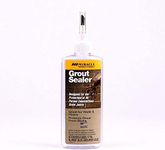Buying Guide for the Best Grout Sealers
Choosing the right grout sealer is essential for maintaining the appearance and longevity of your tiled surfaces. Grout sealers protect the grout from stains, moisture, and mildew, ensuring that your tiles look clean and fresh for years to come. When selecting a grout sealer, consider the type of grout you have, the location of the tiles, and the level of protection you need. Here are some key specifications to help you make an informed decision.Type of SealerGrout sealers come in two main types: penetrating sealers and membrane-forming sealers. Penetrating sealers absorb into the grout and provide protection from within, making them ideal for areas exposed to moisture, like bathrooms and kitchens. Membrane-forming sealers create a protective layer on the surface of the grout, which can be effective in areas with less moisture exposure. Choose a penetrating sealer for high-moisture areas and a membrane-forming sealer for dry areas.
Water ResistanceWater resistance is crucial for grout sealers, especially in areas prone to moisture, such as bathrooms, kitchens, and outdoor spaces. High water resistance prevents water from seeping into the grout, which can cause damage and mold growth. Look for sealers with high water resistance ratings for these areas. If you're sealing grout in a dry area, water resistance may be less critical.
Stain ResistanceStain resistance helps keep your grout looking clean and new by preventing stains from penetrating the surface. This is particularly important in kitchens and high-traffic areas where spills and dirt are common. Sealers with high stain resistance will offer better protection and make cleaning easier. If your tiles are in a low-traffic area, you might not need the highest level of stain resistance.
Ease of ApplicationEase of application refers to how simple it is to apply the sealer to your grout. Some sealers come in spray bottles, while others require brushing or rolling. Consider your comfort level with DIY projects and the size of the area you need to seal. Spray sealers are generally easier to apply and are suitable for small areas, while brush-on or roll-on sealers might be better for larger spaces.
Drying TimeDrying time is the amount of time it takes for the sealer to fully cure and provide protection. Faster drying times are convenient if you need to use the area soon after sealing. However, some sealers with longer drying times may offer more durable protection. Consider your schedule and the urgency of the project when choosing a sealer with an appropriate drying time.
DurabilityDurability refers to how long the sealer will last before needing reapplication. High durability sealers can last several years, reducing the need for frequent maintenance. This is particularly important for high-traffic areas and surfaces exposed to moisture. If your tiles are in a less demanding environment, a sealer with moderate durability may suffice.















